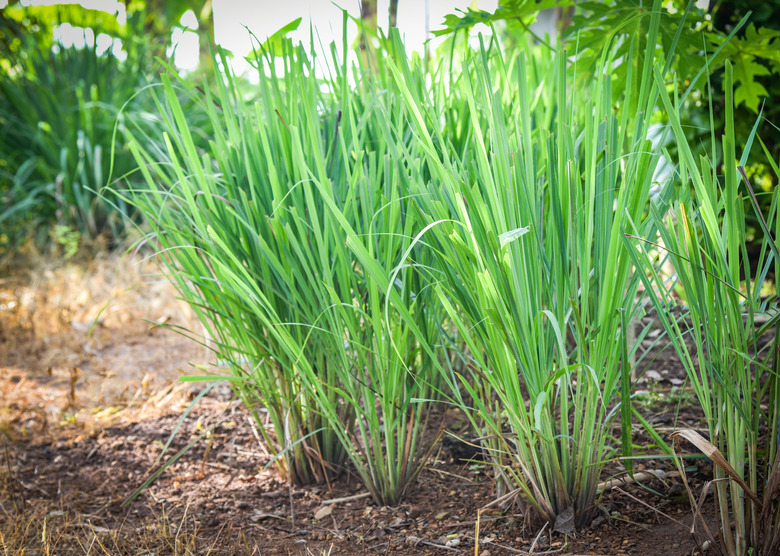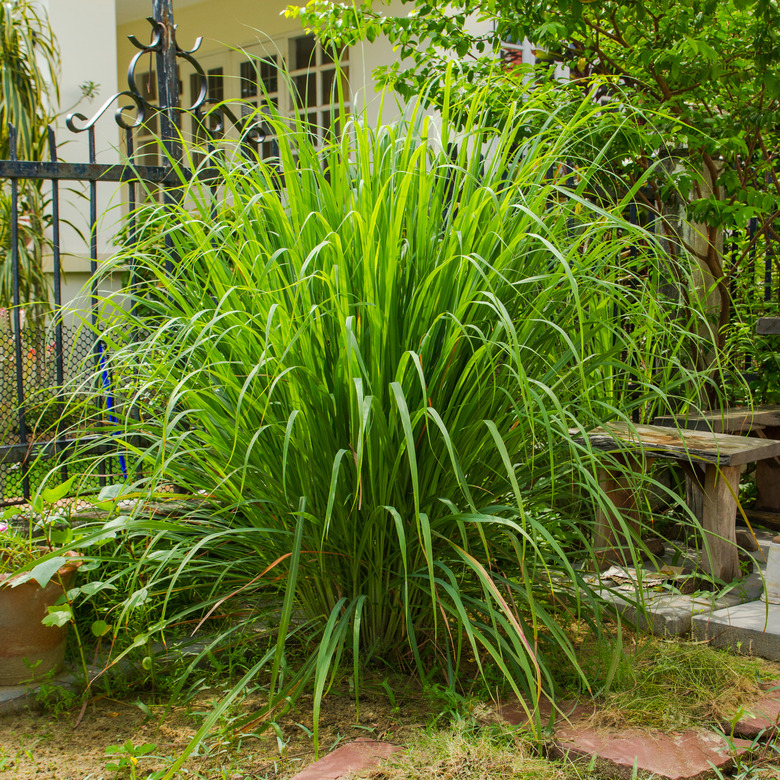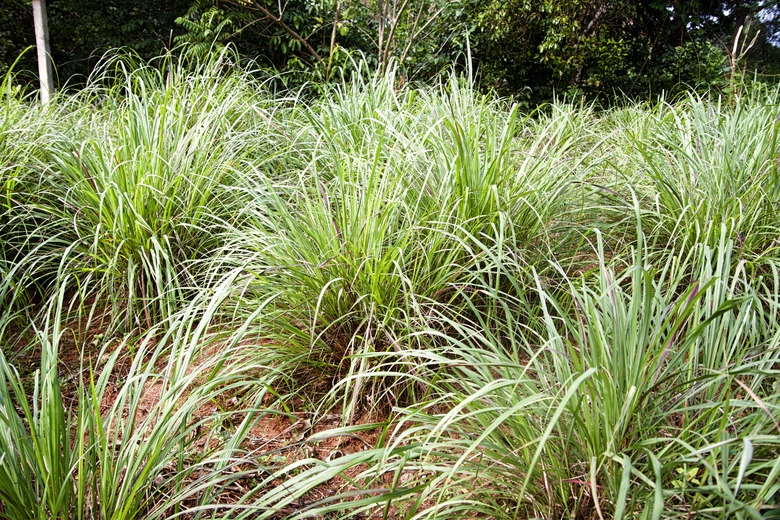How To Grow Lemongrass
If you're a fan of Asian food, especially Thai food, you know the tangy, citrus-like flavor for which lemongrass (Cymbopogon citratus) is noted. You'll find pieces of the fibrous grass, which aren't edible, floating in soups and mixed into curries, and you may finish your meal with a refreshing cup of lemongrass tea. Asian dishes may also include pieces of the inner core of the plant, which are edible and even more flavorful.
The plant responsible for all this aromatic embellishment is a somewhat drought-tolerant clumping grass that grows as a perennial in the tropics and in USDA hardiness zones 10 and 11. It may also survive winters in zones 8 and 9. Gardeners in colder growing zones can grow it as an annual, or they can plant it in containers and transfer it indoors when the weather gets cold. In a single growing season, the lemongrass plant forms a clump that is 2 to 4 feet tall and wide, and although it rarely flowers, the light-green leaves are attractive all on their own.
Besides its citrusy pungency, lemongrass also has health benefits, and lemongrass essential oil has traditionally been used topically as an anti-bacterial and anti-fungal agent. Taken internally, it is reported to act as an anti-oxidant, a stress and pain reliever and an anti-inflammatory. It may even help lower cholesterol and reduce the risk of heart disease.
Best Uses for Lemongrass
Best Uses for Lemongrass
This citrus-y scented plant has a lot of great uses, including:
- A showy and fragrant ornamental grass for an outdoor garden or in greenhouse culture
- An addition to xeriscape landscaping in hot, arid places due to its moderate water requirements
- The centerpiece of a rock garden or, in a pot, where it can adorn a sunny place in the landscape and fill the area with its subtle fragrance
- Culinary or medicinal purposes. The fragrant lemongrass most suited for cultivation for culinary and medicinal purposes is known as West Indian lemongrass, but there's a closely related species called East Indian lemongrass (C. flexuosus) that can also fit the bill.
Tip
Lemongrass is an evergreen in climates in which it grows as a perennial. If you garden outside its hardiness range, you can grow it outdoors in the late spring and summer and harvest the leaves before the frost sets in before bringing in the plant to overwinter inside. Leaves are typically ready about 90 days after you plant cuttings or the seeds germinate, so you can have a successful harvest in any region that has at least three months of warm to hot summer temperatures.
How to Grow Lemongrass
How to Grow Lemongrass
Starting Lemongrass From Seed
Starting Lemongrass From Seed
You can sow seeds outdoors in hot climates, but in places with cold winters, it's best to start them indoors in late winter and transplant them in early spring when nighttime temperatures are steadily above 50 degrees Fahrenheit. Lemongrass seeds need a controlled environment and bottom heat to germinate successfully, so use seedling trays with plastic domes and set the trays on heating mats. You can remove the domes when the seedlings emerge, which takes five to 21 days after sowing.
- Sow the seeds about 1/4 inch deep in sterile seed-starting mix or potting mix and keep the tray in a dark place while keeping the soil temperature a steady 70 degrees.
- Keep the soil moist but not wet; the plastic domes will help retain the humidity necessary for germination. When the seedlings emerge, set the trays in a sunny spot, such as near a sunny window, or use grow lights to keep them well lit.
- When direct-sowing seeds outdoors, wait until the last frost has passed and then sow the seeds 1/4 inch deep and 6 inches apart in a sunny spot with nitrogen-rich, well-draining soil.
- When the seedlings emerge, thin them to a spacing of 2 feet.
Starting Lemongrass From a Seedling
Starting Lemongrass From a Seedling
When transplanting seedlings that are started indoors, harden them off by gradually exposing them to sunlight and cooler temperatures and plant them in rows on loose soil enriched with plenty of organic matter. Plants should be spaced about 2 feet apart or grown in large containers that are at least 12 inches across. A 5-gallon bucket is usually suitable for a single plant.
You can also grow lemongrass from cuttings obtained from lemongrass stalks you buy at the grocery store. Once you've prepared the cuttings by soaking them until roots appear, plant them in the garden the same distance apart that you would plant seedlings.
In What Zone Does Lemongrass Grow Best?
In What Zone Does Lemongrass Grow Best?
Lemongrass is not cold hardy and will die off as soon as the winter frost arrives, so it's best grown in the warmth of zones 10 and 11. Gardeners in zones 8 and 9 can grow lemongrass outdoors, but the plants have to be protected from cold winds, and the soil moisture must be carefully controlled. When moisture builds up, the soil gets colder, and lemongrass has no tolerance for cold.
In regions further north, it's only possible to grow lemongrass outdoors as an annual and only if the growing season is long enough for the plant to mature. Of course, lemongrass can be grown any time of year in a controlled indoor environment such as a greenhouse.
When Should You Plant Lemongrass?
When Should You Plant Lemongrass?
In northern climates where lemongrass is grown as an annual, you want to get it in the ground in early spring as soon as the soil and air temperatures fall no lower than 50 degrees at night. In these regions, starting seeds or cuttings indoors is recommended so that you have well-rooted transplants ready to go. As long as you can plant transplants before June, you should be able to harvest fresh lemongrass stalks before the first fall frost.
Soil, Sunlight, and Water Recommendations for Lemongrass
Soil, Sunlight, and Water Recommendations for Lemongrass
Loose, fertile soil is best for lemongrass, and the ideal pH is a slightly acidic 6.5 to a neutral 7.0. Lemongrass won't grow well in clay unless you add some perlite or large, chunky compost to improve aeration. If the soil is loamy, fortify it with compost in a two-to-one ratio: two parts soil to one part compost. A weekly addition of high-nitrogen fertilizer, such as an 10-6-4 mix, aids the development of the green leaves.
Although lemongrass is moderately drought tolerant, it prefers moist soil and should be watered periodically, particularly when the ground dries out to a depth of several inches. If you live in a region with high humidity, you should be able to grow large plants because lemongrass, being a tropical plant, loves humidity. It also loves sun and should get as much direct sunlight as your garden can offer.
How to Propagate Lemongrass
How to Propagate Lemongrass
Besides collecting seeds and sowing them indoors or directly in the garden, you can also propagate lemongrass by using cuttings, and this is probably the easiest way to grow it. You can obtain the cuttings from your own plants or from stalks you buy in the store.
- Put the fresh lemongrass stalk in a cup of water with the bottom end submerged and wait two to three weeks for roots to appear.
- Then, plant it in the garden or in a container.
Another way to propagate lemongrass is to divide existing plants:
- Separate the stalks at the base and choose two or three strong ones.
- Pull them out by the roots using a knife if necessary to separate the roots.
- Plant the divided stalks in another part of the garden and now, instead of one lemongrass clump, you have two. You can do this in regions that are warm enough for the plant to grow as a perennial, and the best time of year to do it is early spring.
How to Winterize Lemongrass
How to Winterize Lemongrass
In cold regions where lemongrass can't survive outdoors during the winter, you can overwinter them indoors.
- Cut the stalks back to a few inches tall and plant them in pots.
- Keep the pots on a sunny, south-facing windowsill and keep the soil barely moist because the plants will go dormant and won't use much water.
- Plant them back outside when the nighttime temperature is consistently above 50 degrees.
How to Harvest Lemongrass
How to Harvest Lemongrass
You can harvest lemongrass as soon as the leaves are 12 inches long and the bases are 1/2 inch in diameter. You can cut the stalks at ground level or pull an entire stalk, roots and all, for the bulbous base, which looks like a scallion and contains the soft, edible lemongrass heart. If you want to save the hearts, cut off the leaves and peel away the outer fibrous layers. You can then freeze the hearts whole, or you can chop them first.
Common Pests and Other Problems for Lemongrass
Common Pests and Other Problems for Lemongrass
Lemongrass, like citronella, actually repels may types of insects, so it isn't bothered by many pests, but spider mites and aphids are two exceptions. You can control both of these tiny crawling insects and their colonies by spraying the leaves with neem oil or an insecticidal soap.
In some places, the grass bagworm, a moth larva, will eat holes in lemongrass leaves. This worm rarely kills the plant, and you can control it by picking it off the plant or spraying or dusting the plant with Bacillus thuringiensis (Bt).
Common Diseases for Lemongrass
Common Diseases for Lemongrass
The most common disease for lemongrass is a particular kind of rust, Puccinia nakanishikii, that creates yellow spots and brown streaks on the leaves and can damage leaves and even kill the plant. This is a fungal disease that you can minimize by watering the base of the plant instead of the leaves. At the first signs of infection, treat the leaves by spraying a copper fungicide. If the disease becomes advanced, it's hard to control, and you may need to discard the plant.
In addition to rust, lemongrass is susceptible to leaf blight, which is caused by a pathogen in the soil that also causes root rot. The leaves develop yellow splotches and may wilt in hot weather. This pathogen lives in the soil for up to five years, but you can control it by inoculating with a Trichoderma inoculant. This will also help control Fusarium strains that also live in the soil and cause leaf spot and clump rot.


